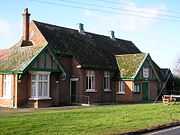Great Bromley
| Great Bromley | |
 St. George, Great Bromley |
|
 Great Bromley | |
| OS grid reference | TM083262 |
|---|---|
| District | Tendring |
| Shire county | Essex |
| Region | East |
| Country | England |
| Sovereign state | United Kingdom |
| Post town | Colchester |
| Postcode district | CO7 7 |
| Dialling code | 01206 |
| Police | Essex |
| Fire | Essex |
| Ambulance | East of England |
| EU Parliament | East of England |
| UK Parliament | North Essex |
Great Bromley is a village and civil parish in the Tendring district of Essex. It lies 6 kilometres (4 mi) south of Manningtree and 9 kilometres (6 mi) east of Colchester and includes the hamlets of Balls Green and Hare Green. The A120 trunk road (with the A133 as a spur off it) cuts right through the middle of the parish.
History
Ancient burial mounds have been found in and around Great Bromley.
The village church dates from the 14th and 15th centuries and is dedicated to Saint George but is sometimes referred to as the "Cathedral of the Tendring Hundred."
The village and the surrounding area, like much of East Anglia, had residents who were seething with Puritan sentiment during the early and middle years of the 17th century. By 1635, brothers Gregory and Simon Stone had departed for the Massachusetts Bay Colony as part of the wave of emigration that occurred during the Great Migration. They settled in Cambridge and Watertown, Massachusetts respectively.[1]
Great Bromley Hall (now known as the Seven Rivers Cheshire home) was the ancestral seat of the Mannock family and dates to before the 17th century. One of the notable residents of the great home was Sir Thomas Bowles who was the Justice of the Peace for Essex during much of the 17th century. In that capacity, he was involved in the county response to the witchcraft hysteria that was then sweeping the populace and he dealt with those accused of witchcraft harshly. His son Paul Bowes achieved some degree of fame when he posthumously edited and published the journals associated with his uncle, Sir Simonds d'Ewes, a noted antiquarian. The work was published as "Journals of all the Parliaments during the Reign of Queen Elizabeth."
It is not known whether Great Bromley suffered any damage during World War II but the village was situated in the militarily precarious position of being more or less on the boundary between two Groups of Fighter Command (the 11th and 12th). More specifically between the sectors known as Debden and Northweald.[2] There was an RAF chain home low station and the site was known as RAF Bromley. Bombs were dropped by the Germans during the early part of the war when they were attempting to disrupt radar activity. This was abandoned when bombing seemed to have little effect on any part of the chain system. Ventor on the Isle of Wight was disabled for several days but this was covered up by the British forces installing a portable transmitter working on the same frequency. many of the above and below ground bunkers are still present. The wooden receiving towers have gone but one of the 315ft steel tower remains. A guardhouse can still be seen on the radar site and also at the entrance to Hamilton lodge in the main village opposite the village hall.
The old radar site is reputedly haunted by the ghost of an RAF aviator who crashed nearby and as RAF Bromley was the nearest establishment his body was brought here. Apparently his radio was damaged and he was shot down by friendly anti aircraft fire. He has been seen tapping the code's of the day in the buildings that are still on site. The entire site is still fenced and contains bunkers in private ownership.
In 2005, a motorist was shot in the back with a longbow during an apparent ambush on a country lane near Great Bromley. The man had stopped to help a woman who was crouching near a parked van, who later turned out to be the longbowman's accomplice. As the man approached the woman, he was shot in the back from 20 feet away, but was able to escape. The longbowman and his female assistant were never caught.[3]
Today
In 2006, the church of St. George received a £2,000 grant from the Friends of Essex Churches Trust to repair the building's windows.
References
- ↑ Thompson, Roger, Mobility & Migration, East Anglian Founders of New England, 1629-1640, Amherst: University of Massachusetts Press, 1994.
- ↑ Smurthwaite, David, Battlefields of Britain, The Complete Illustrated Guide, New York: Congdon & Weed, Inc., 1984, 210.
- ↑ The Sun
External links
| Wikimedia Commons has media related to Great Bromley. |
- Great Bromley parish website
- Great Bromley Parish Council
- Entry in Kelly's Directory of Essex, 1882
- Friends of Essex Churches Trust website
